Your back is riddled with muscles of many different lengths, moving in many different directions and coordinating many actions. But it also suffers from the “out-of-sight, out-of-mind” phenomenon.
With so much variety in the back musculature, it can be hard to know exactly what part of the back is working when you are doing any single movement. (Unless it’s your low back that’s working too hard, which is fairly obvious.)
There are so many different ways you use your back muscles that it can be hard to sort out exactly what muscle(s) are active when. In truth, you don’t need to know down to a high level of detail. You just need to remember that, like most muscles, their job is to either create motion or create tension (or stiffness with little to no change in length.)
The following TRX exercises were chosen or created with these factors in mind. There is typically a variety of the pulling angle and/or rotation of the arm muscles to assist with pulling. Mix them into your clients’ back program and they’ll keep rocking those tanks and strapless dresses.
Exercises
Alternating Single-arm Row
Set-up and Technique: fully shortened, single handle, facing anchor, wide stance
Two versions of this exercise:
Stability
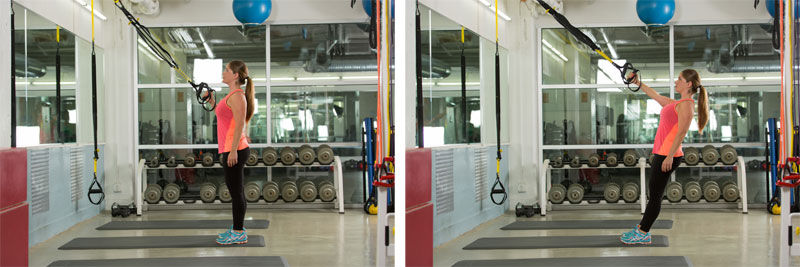
With one arm, pull yourself toward the anchor point. At the top of the pull, switch hands. As you return to the starting position, minimize rotation in the torso (i.e., keep hips and shoulders square).
Mobility
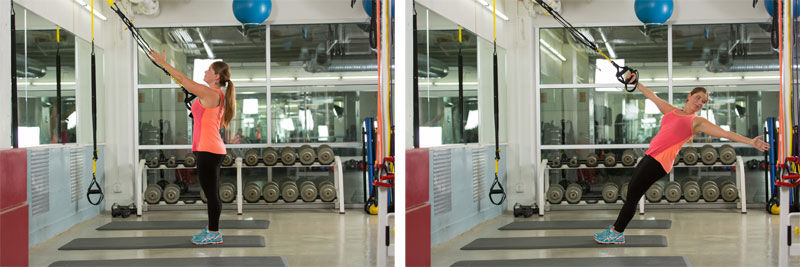
With one arm, pull yourself toward the anchor point. At the top of the pull, switch hands. As you return to the starting position, allow and control rotation so that the torso opens away from the arm holding the strap. Use an integrated pulling motion of the hips, back and arm to create the pull.
Why Do It: Pulling with a single arm is an essential life skill. Sometimes we need to pull while maintaining a rigid torso and prevent rotation, while other times we need to generate a more powerful, integrated pull using the full body to create the pull and rotation.
1.5 Rep Row

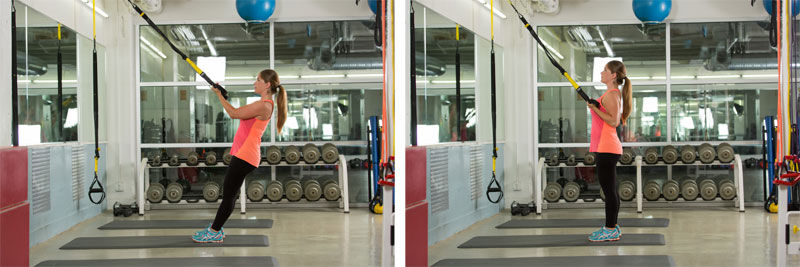
Set-up and Technique: fully shortened, facing anchor
Perform a full rep of a rotating grip row. Your hands will start with the palms turned down, while the arms are straight. As you perform the movement, rotate your hands so that at the finish with your palms turned up. As you lower out of the row position, stop halfway and pull yourself again to the top of the movement.
Why Do It: You will get twice as many reps in the top half of the pull (the hardest and most important part of the movement for the back muscles.) For example, if you were to perform eight reps of this exercise, you would get 16 reps in the top of half of the movement and eight reps in the bottom half. One full cycle of 1.5 reps is one rep.
Lat Pull-up
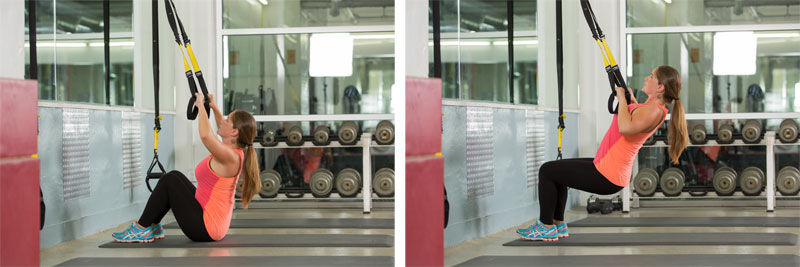
Set-up and Technique: fully shortened (possibly over-shortened based on arm length), facing anchor
Sit either on or just above the floor with your feet well in front of you and the knees bent. Bring your ribs to your hips and point the top of your head toward the anchor point as you pull yourself up toward the anchor point.
Why Do It: This exercise uses body weight, but it’s like a lat pull-down. You get the benefit of a bodyweight pull-up with the motion and feel of a lat pull-down. Be sure to keep the ribs close to the hips and the feet positioned so that the knees stay behind or just above the feet at the top of the pull.
High-low Row

Set-up and Technique: fully shortened, facing anchor
Perform a high row while moving toward the anchor and the return, then lower your elbows and rotate your hands to perform a low row. On the high row, ensure that your hands move away from each other as you pull.
Why Do It: The high row works more of the rear shoulder muscles, while the low row works more of the back muscles. The grip changes provide a lot of variety to the pulling load for your entire back and shoulder musculature. Be sure to keep the sternum lifted and high during all parts of the movement.
Back Curls
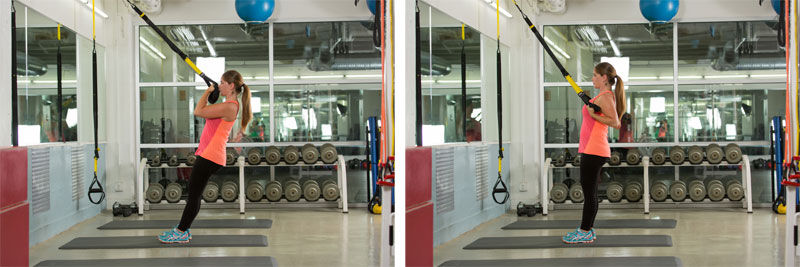
Set-up and Technique: fully shortened, facing anchor
Yes, you read that right: back curls. Start at the top of a curl position with elbows flexed (and they will stay that way throughout the movement). You’ll be moving the shoulder attachment of the biceps, not the elbow end of the muscle. Pull the elbows down and immediately pull and tuck them behind you. Return to the starting position by driving the hands up and forward, maintaining the bent-elbow position of the curl throughout.
Why Do It: The bigger lat muscles and the smaller middle-back muscles will be doing a lot of work from a lot of angles. The more your back works, the less hard your arms work (they will be working to some extent), so this exercise gives a lot of input and feedback on the go as to the quality of your back muscle use.




 by
by 









 by
by